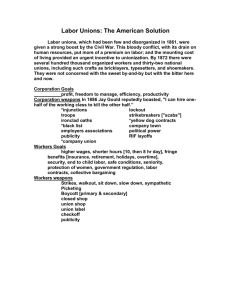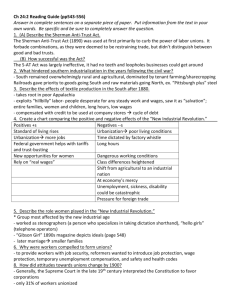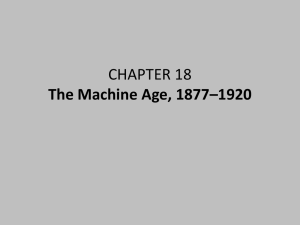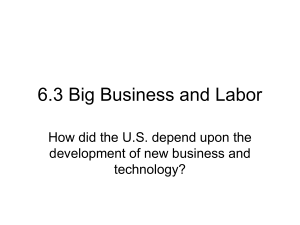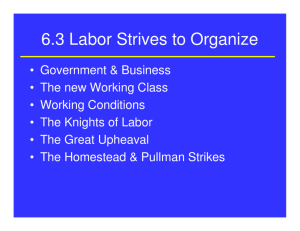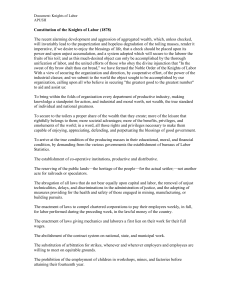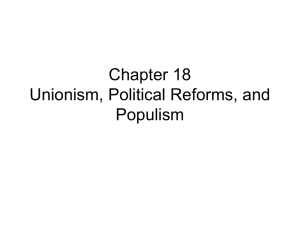6.2 American Labor Movement
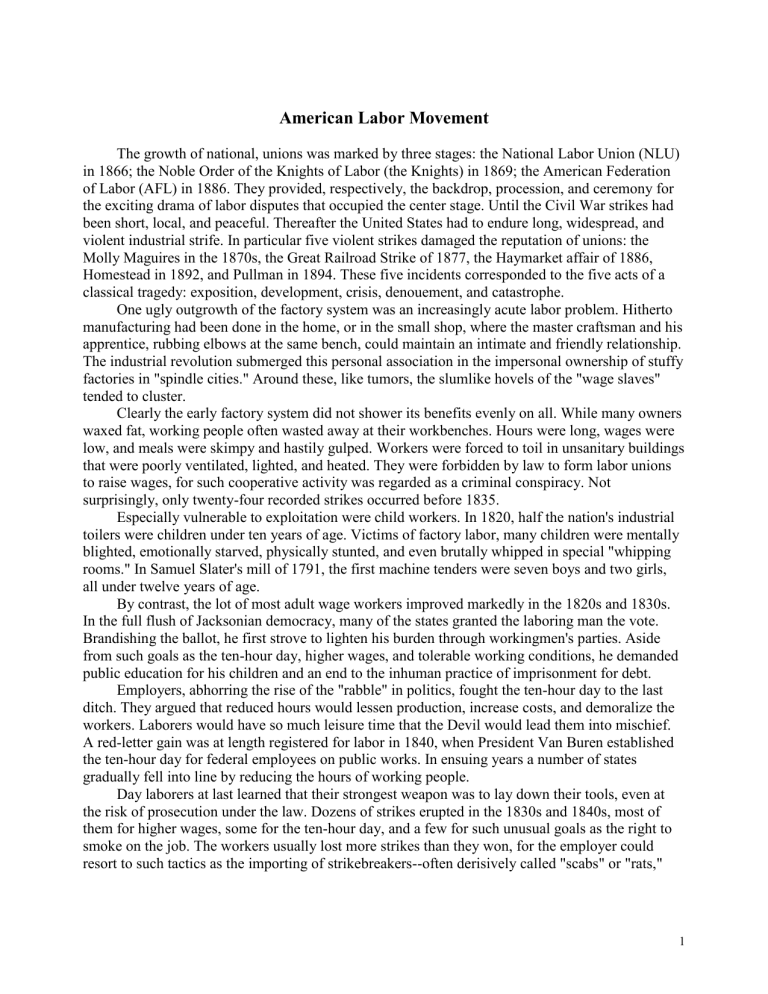
American Labor Movement
The growth of national, unions was marked by three stages: the National Labor Union (NLU) in 1866; the Noble Order of the Knights of Labor (the Knights) in 1869; the American Federation of Labor (AFL) in 1886. They provided, respectively, the backdrop, procession, and ceremony for the exciting drama of labor disputes that occupied the center stage. Until the Civil War strikes had been short, local, and peaceful. Thereafter the United States had to endure long, widespread, and violent industrial strife. In particular five violent strikes damaged the reputation of unions: the
Molly Maguires in the 1870s, the Great Railroad Strike of 1877, the Haymarket affair of 1886,
Homestead in 1892, and Pullman in 1894. These five incidents corresponded to the five acts of a classical tragedy: exposition, development, crisis, denouement, and catastrophe.
One ugly outgrowth of the factory system was an increasingly acute labor problem. Hitherto manufacturing had been done in the home, or in the small shop, where the master craftsman and his apprentice, rubbing elbows at the same bench, could maintain an intimate and friendly relationship.
The industrial revolution submerged this personal association in the impersonal ownership of stuffy factories in "spindle cities." Around these, like tumors, the slumlike hovels of the "wage slaves" tended to cluster.
Clearly the early factory system did not shower its benefits evenly on all. While many owners waxed fat, working people often wasted away at their workbenches. Hours were long, wages were low, and meals were skimpy and hastily gulped. Workers were forced to toil in unsanitary buildings that were poorly ventilated, lighted, and heated. They were forbidden by law to form labor unions to raise wages, for such cooperative activity was regarded as a criminal conspiracy. Not surprisingly, only twenty-four recorded strikes occurred before 1835.
Especially vulnerable to exploitation were child workers. In 1820, half the nation's industrial toilers were children under ten years of age. Victims of factory labor, many children were mentally blighted, emotionally starved, physically stunted, and even brutally whipped in special "whipping rooms." In Samuel Slater's mill of 1791, the first machine tenders were seven boys and two girls, all under twelve years of age.
By contrast, the lot of most adult wage workers improved markedly in the 1820s and 1830s.
In the full flush of Jacksonian democracy, many of the states granted the laboring man the vote.
Brandishing the ballot, he first strove to lighten his burden through workingmen's parties. Aside from such goals as the ten-hour day, higher wages, and tolerable working conditions, he demanded public education for his children and an end to the inhuman practice of imprisonment for debt.
Employers, abhorring the rise of the "rabble" in politics, fought the ten-hour day to the last ditch. They argued that reduced hours would lessen production, increase costs, and demoralize the workers. Laborers would have so much leisure time that the Devil would lead them into mischief.
A red-letter gain was at length registered for labor in 1840, when President Van Buren established the ten-hour day for federal employees on public works. In ensuing years a number of states gradually fell into line by reducing the hours of working people.
Day laborers at last learned that their strongest weapon was to lay down their tools, even at the risk of prosecution under the law. Dozens of strikes erupted in the 1830s and 1840s, most of them for higher wages, some for the ten-hour day, and a few for such unusual goals as the right to smoke on the job. The workers usually lost more strikes than they won, for the employer could resort to such tactics as the importing of strikebreakers--often derisively called "scabs" or "rats,"
1
and often fresh off the boat from the Old World. Labor long raised its voice against the unrestricted inpouring of wage-depressing and union-busting immigrant workers.
Labor's early and painful efforts at organization had netted some 300,000 trade unionists by
1830. But such encouraging gains were dashed on the rocks of hard times following the severe depression of 1837. As unemployment spread, union membership shriveled. Yet toilers won a hope-giving legal victory in 1842. The supreme court of Massachusetts ruled in the case of
Commonwealth v. Hunt that labor unions were not illegal conspiracies, provided that their methods were "honorable and peaceful." This enlightened decision did not legalize the strike overnight throughout the country, but it was a significant signpost of the times. Trade unions still had a rocky row to hoe, stretching ahead for about a century, before they could meet management on relatively even terms.
The National Labor Union, organized in 1866, represented a giant bootstride by the workers.
It lasted six years and attracted the impressive total of some 600,000 members, including the skilled, unskilled, and farmers. Its keynote was social reform, although it agitated for such specific goals as the eight-hour day and the arbitration of industrial disputes. It finally succeeded in winning an eight-hour day for government workers, but the devastating depression of the 1870s dealt it a knockout blow. Labor was generally rocked back on its heels during these hectic years. Wage reductions in 1877 touched off a series of strikes on the railroads that were so violent as to verge on civil war. Federal troops were required to restore order, and scores of people--strikers and troops alike--were killed.
A new organization--the Knights of Labor--seized the torch dropped by the defunct National
Labor Union. Officially known as The Noble and Holy Order of the Knights of Labor, it began inauspiciously in 1869 as a secret society, with a private ritual, passwords, and a grip. Secrecy, which continued until 1881, would forestall possible reprisals by employers. The Knights of Labor, like the National Labor Union, sought to include all workers in "one big union." Their slogan was
"An injury to one is the concern of all." A welcome mat was rolled out for the skilled and unskilled, for men and women, for whites and underprivileged blacks, some 90,000 of whom joined. The
Knights excluded only liquor dealers, professional gamblers, lawyers, bankers, and stockbrokers.
Setting up broad goals, the embattled Knights refused to thrust their lance into politics.
Instead they campaigned for economic and social reform, including producers' cooperatives and codes for safety and health. Voicing the war cry "Labor is the only creator of values and capital," they frowned upon industrial warfare while fostering industrial arbitration. The ordinary workday was then ten hours or more, and the Knights waged a determined campaign for the eight-hour stint.
A favorite song of these years ran,
Hurrah, hurrah, for labor, it is mustering all its powers,
And shall march along to victory with the banner of eight hours.
Under the eloquent but often erratic leadership of Terence V. Powderly, an Irish-American of nimble wit and fluent tongue, the Knights won a number of strikes for the eight-hour day. When the
Knights staged a successful strike against Jay Gould's Wabash Railroad in 1885, membership mushroomed, to about three-quarters of a million workers.
Despite their outward success, the Knights were riding for a fall. They became involved in a number of May Day strikes in 1886, about half of which failed. A focal point was Chicago, which contained about eighty thousand Knights. The city was also honeycombed with a few hundred
2
anarchists, many of them foreign-born, who were advocating a violent overthrow of the American government.
Tensions rapidly built up to the bloody Haymarket Square episode. Labor disorders had broken out, and on May 4, 1886, the Chicago police advanced on a meeting called to protest alleged brutalities by the authorities. Suddenly a dynamite bomb was thrown that killed or injured several dozen people, including police.
Hysteria swept the Windy City. Eight anarchists were rounded up, although nobody proved that they had anything to do directly with the bomb. But the judge and jury held that since they had preached incendiary doctrines, they could be charged with conspiracy. Five were sentenced to death, one of whom committed suicide, and the other three were given stiff prison terms.
Agitation for clemency mounted. In 1892, some six years later, John P. Altgeld, a Germanborn Democrat of strong liberal tendencies, was elected governor of Illinois. After studying the
Haymarket case exhaustively, he pardoned the three survivors. Violent abuse was showered on him by conservatives, unstinted praise by those who thought the men innocent. He was defeated for reelection and died a few years later in relative obscurity, "The Eagle Forgotten." Whatever the merits of the case, Altgeld displayed courage in opposing what he regarded as a gross injustice.
The Haymarket Square bomb helped blow the props from under the Knights of Labor. They were associated in the public mind, though mistakenly, with the anarchists. The eight-hour movement suffered correspondingly, and subsequent strikes by the Knights met with scant success.
The right to choose to strike carried with it the right to lose the strike.
Another fatal handicap of the Knights was their inclusion of both skilled and unskilled workers. Unskilled labor could easily be replaced by strikebreaking "scabs." High-class craft unionists, who enjoyed a semi-monopoly of skills, could not readily be supplanted and hence enjoyed a superior bargaining position. They finally wearied of sacrificing this advantage on the altar of solidarity with their unskilled coworkers and sought refuge in a federation of exclusively skilled craft unions--the American Federation of Labor. The desertion of the skilled craft unionists dealt the Knights a body blow. By the 1890s they had melted away to 100,000 members, and these gradually fused with other protest groups of that decade.
The elitist American Federation of Labor, born in 1886, was largely the brainchild of squat, square-jawed Samuel Gompers. This colorful Jewish cigar maker, born in a London tenement and removed from school at age ten, was brought to America when thirteen. Taking his turn at reading informative literature to fellow cigar makers in New York, he was pressed into overtime service because of his strong voice. Rising spectacularly in the labor ranks, he was elected president of the
American Federation of Labor every year except one from 1886 to 1924.
Significantly, the American Federation of Labor was just what it called itself--a federation. It consisted of an association of self-governing national unions, each of which kept its independence, with the AF of L unifying overall strategy. No individual laborer as such could join the central organization.
Gompers adopted a down-to-earth approach, soft-pedaling attempts to engineer sweeping social reform. A bitter foe of socialism, he kept the federation squarely on the cautious path of conservatism. He had no quarrel with capitalism as such, but he wanted labor to win its fair share.
All he wanted, he said simply, was "more." His objectives were better wages and hours, as well as other improved conditions for the worker. Another major goal of Gompers was the "trade agreement" authorizing the "closed shop"--or all-union labor. His chief weapons were the walkout and the boycott, enforced by "We don't patronize" signs. The stronger craft unions of the
3
federation, by pooling funds, were able to amass a war chest that would enable them to ride out prolonged strikes.
The AF of L thus established itself on solid but narrow foundations. Although attempting to speak for all workers, it fell far short of being representative of them. Composed of skilled crafts, like the carpenters and the bricklayers, it was willing to let unskilled laborers, including women and especially blacks, fend for themselves. Though hard-pressed by big industry, the federation was basically nonpolitical. But it did attempt to persuade members to reward friends and punish foes at the polls. The AF of L weathered the panic of 1893 reasonably well, and by 1900 it could boast a membership of 500,000. Critics referred to it, with questionable accuracy, as "the labor trust."
Labor disorders continued throughout the years from 1881 to 1900, during which there was an alarming total of over 23,000 strikes. These disturbances involved 6,610,000 workers, with a total loss to both employers and employees of $450 million. The strikers lost about half their strikes, and won or compromised the remainder. Perhaps the gravest weakness of organized labor was that it still embraced only a small minority of all working people--about 3 percent in 1900.
But attitudes toward labor had begun to change perceptibly by 1900. The public was beginning to concede the right of workers to organize, to bargain collectively, and to strike. As a sign of the times, Labor Day was made a legal holiday by act of Congress in 1894. A few enlightened industrialists had come to perceive the wisdom of avoiding costly economic warfare by bargaining with the unions and signing agreements. But the vast majority of employers continued to fight organized labor, which achieved its grudging gains only after recurrent strikes and frequent reverses. Nothing was handed to it on a silver platter. Management still held the whip hand, and several trouble-fraught decades were to pass before labor was to gain a position of relative equality with capital. If the age of big business had dawned, the age of big labor was still some distance over the horizon.
A "work or fight" rule, requiring all able-bodied males to be regularly employed in some useful occupation, was issued by the War Department in 1918. Fortunately for the Allied cause,
Samuel Gompers and his powerful American Federation of Labor gave loyal support to the war effort.
Yet labor harbored grievances. Admittedly, the wages of 1914 had nearly doubled by 1918, but inflationary prices, boosted by war, feverishly kept pace with the wage scale. (Prices, too, nearly doubled between 1916 and 1920.) Not even the call of patriotism and Wilsonian idealism could stifle all labor disputes; during the conflict there were some six thousand strikes. The
National War Labor Board, with former President Taft as co-chairman, was finally established as the supreme court for labor disputes. More than a thousand cases came before it.
Some of the most crippling labor sabotage was engineered by the left-wing IWWs, popularly known as the "I Won't Works" or "Wobblies." As transient laborers in such industries as fruit and lumber, the "Wobblies" were victims of some of the worst working conditions in the country. When they protested, many of the "Wobblies" were arrested, beaten up, or run out of town.Ó
Sweat of the laborer lubricated the vast new industrial machine. Yet the wage workers did not share proportionately with their employers in the benefits of the age of big business.
The worker, suggestive of the Roman galley slave, was becoming a lever-puller in a giant mechanism. Individual originality and creativity were being stifled, and less value than ever before was being placed on manual skills. Before the Civil War, the worker might have toiled in a small plant whose owner hailed the employee in the morning by first name and inquired after the family's health. But now the factory hand was employed by a corporation--depersonalized, bodiless,
4
soulless, and often conscienceless. The directors knew the worker not; and in fairness to their stockholders they did not feel that they could engage in large-scale private philanthropy.
As new machines were invented, many of the regular employees were thrown out of work. In the long run more jobs were created than destroyed, but in the short run the manual worker was often hard hit. Labor is the most perishable of all commodities. A pair of shoes unsold may be sold tomorrow, but today's labor not sold today is lost forever.
A glutted labor market, moreover, severely handicapped the wage earners. The vast new railroad network could shuttle unemployed workers, including blacks and immigrants, into areas where wages were high and thus beat standards down. Inpouring Europeans further worsened conditions. During the 1880s and 1890s and later, the labor market had to absorb several hundred thousand unskilled workers a year.
Individual workers were powerless to battle single-handedly against giant industry. Forced to organize and fight for basic rights, they found the dice heavily loaded against them. The corporation could dispense with the individual worker much more easily than the worker could dispense with the corporation. Employers could pool vast wealth through thousands of stockholders, retain high-priced lawyers, buy up the local press, and put pressure on the politicians.
They could import strikebreakers ("scabs") and employ thugs to beat up labor organizers. In 1886
Jay Gould reputedly boasted, "I can hire one-half of the working class to kill the other half."
Corporations had still other weapons in their arsenals. They could call upon the federal courts--presided over by well-fed and conservative judges--to issue injunctions ordering the strikers to cease striking. If defiance and disorders ensued, the company could request the state and federal authorities to bring in troops. Employers could lock their doors against rebellious workers--a process called the "lockout"--and then starve them into submission. They could compel them to sign "ironclad oaths" or "yellow dog contracts," both of which were solemn agreements not to join a labor union. They could put the names of agitators on a "black list" and circulate it among fellow employers. A corporation might even own the "company town," with its high-priced grocery stores and "easy" credit. Often the worker sank into perpetual debt--a status that strongly resembled serfdom. Countless thousands of blackened coal miners were born in a company house, nurtured by a (high-priced) company store, and buried in a company graveyard--prematurely dead.
The public, annoyed by recurrent strikes, grew deaf to the outcry of the worker. American wages were perhaps the highest in the world, although a dollar a day for pick-and-shovel labor does not now seem excessive. Carnegie and Rockefeller had battled their way to the top, and the view was common that the laborer could do likewise. Somehow the strike seemed like a foreign importation--socialistic and hence unpatriotic. Big business might combine into trusts to raise prices, but the worker must not combine into unions to raise wages. Unemployment seemed to be an act of God, who somehow would take care of the laborer.
Labor unions, which had been few and disorganized in 1861, were given a strong boost by the Civil War. This bloody conflict, with its drain on human resources, put more of a premium on labor; and the mounting cost of living provided an urgent incentive to unionization. By 1872 there were several hundred thousand organized workers and thirty-two national unions, including such crafts as bricklayers, typesetters, and shoemakers. They were not concerned with the sweet by-andby but with the bitter here and now.
The knot of monopoly was further cut by the Clayton Anti-Trust Act of 1914. It lengthened the shopworn Sherman Act's list of business practices that were deemed objectionable, including price discrimination and interlocking directorates (whereby the same individuals served as directors of supposedly competing firms).
5
The Clayton Act also conferred long-overdue benefits on labor. Conservative courts had unexpectedly been ruling that trade unions fell under the antimonopoly restraints of the Sherman
Act. A classic case involved striking hatmakers in Danbury, Connecticut, who were assessed triple damages of more than $250,000, which resulted in the loss of their savings and homes. The Clayton
Act therefore sought to exempt labor and agricultural organizations from antitrust prosecution, while explicitly legalizing strikes and peaceful picketing.
Union leader Samuel Gompers hailed the act as the Magna Charta of labor because it legally lifted human labor out of the category of "a commodity or article of commerce." But the rejoicing was premature, as conservative judges in later years continued to clip the wings of the union movement.
6
